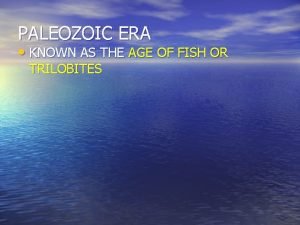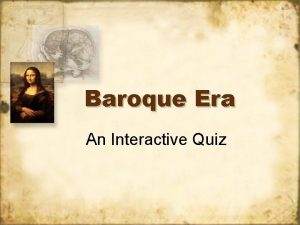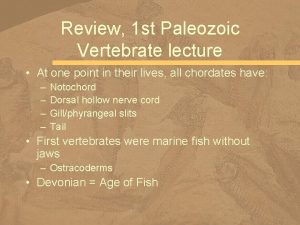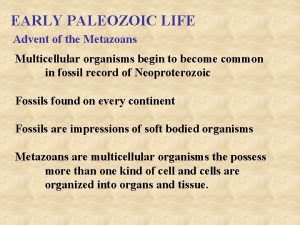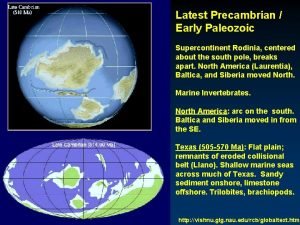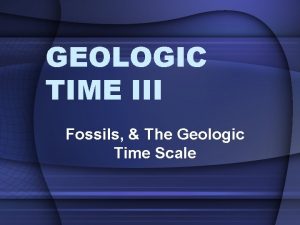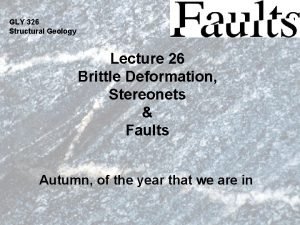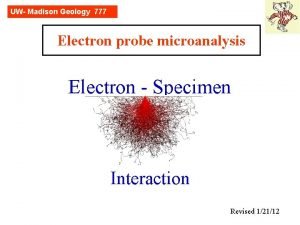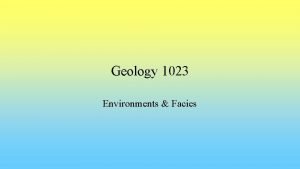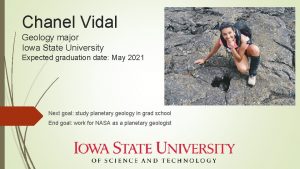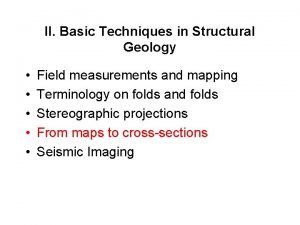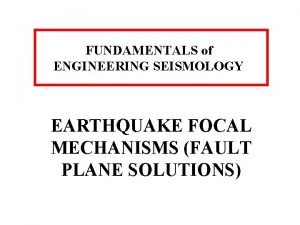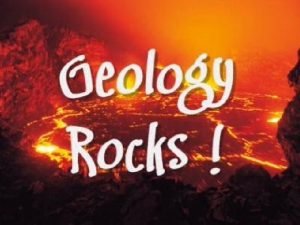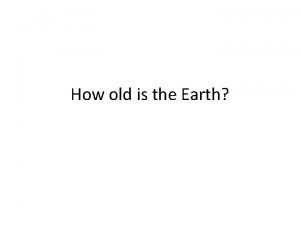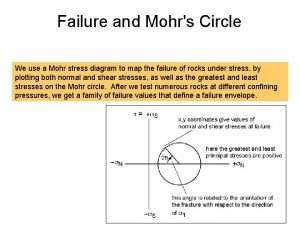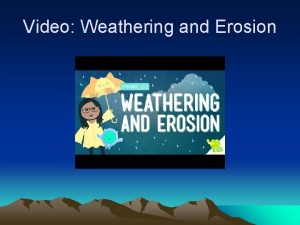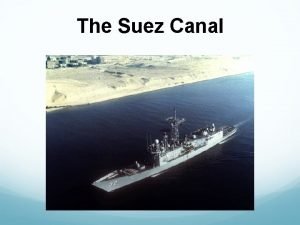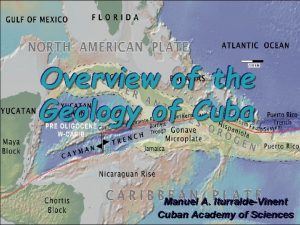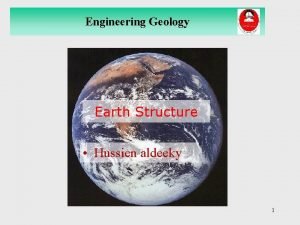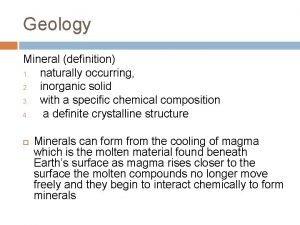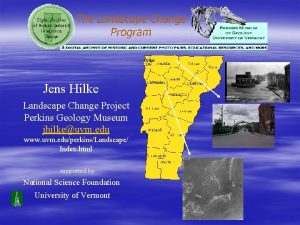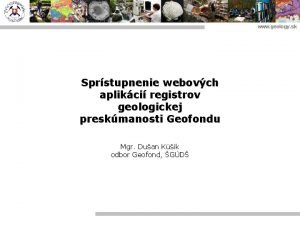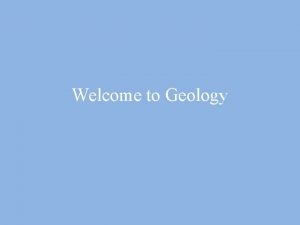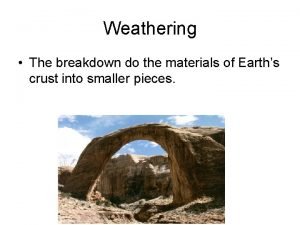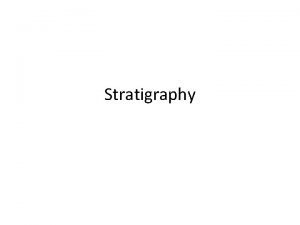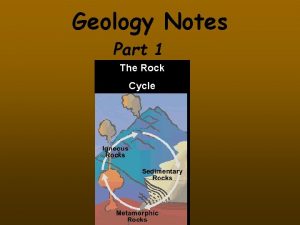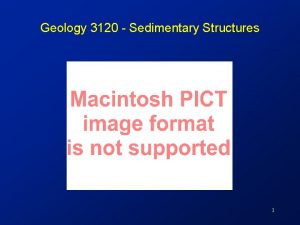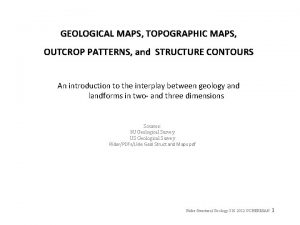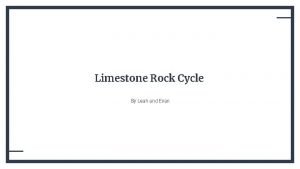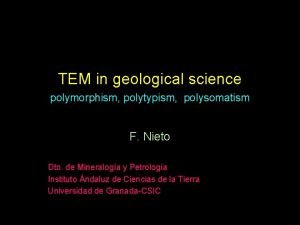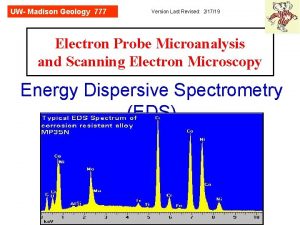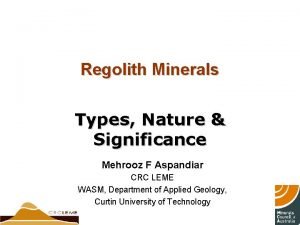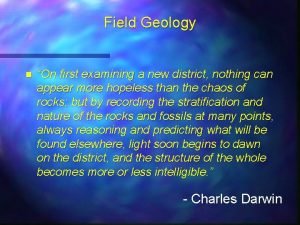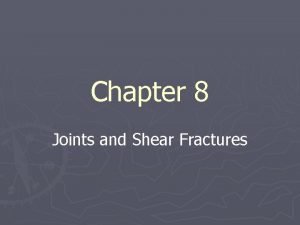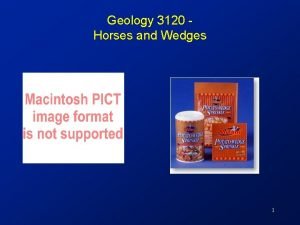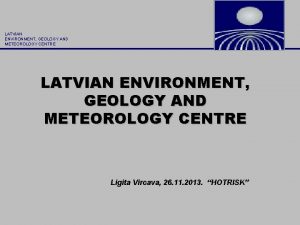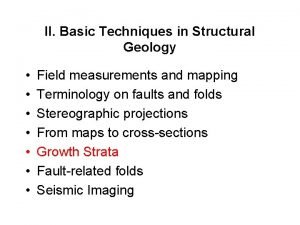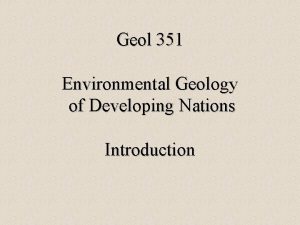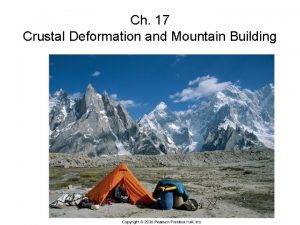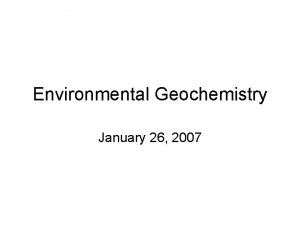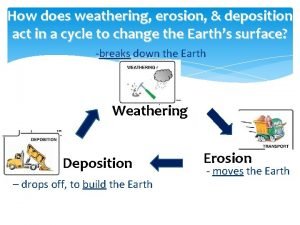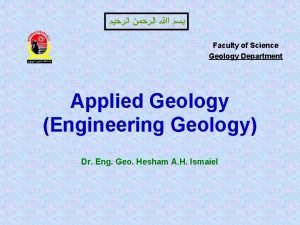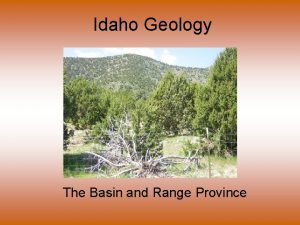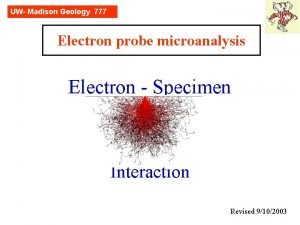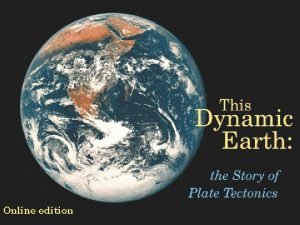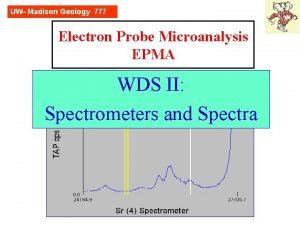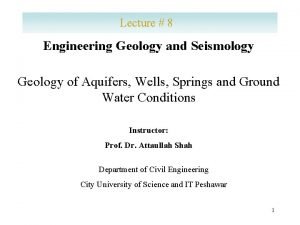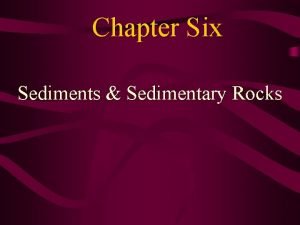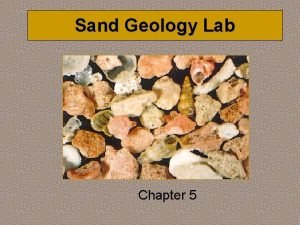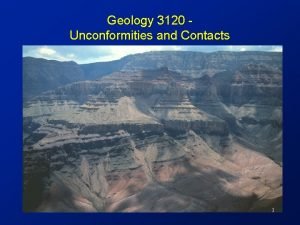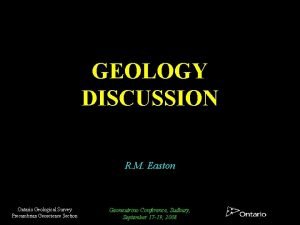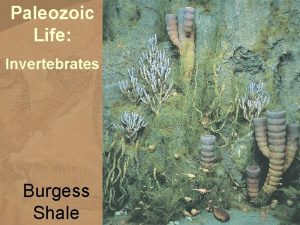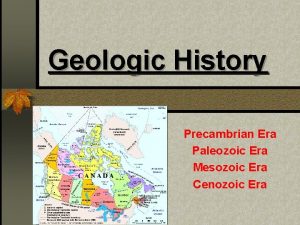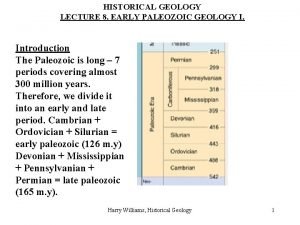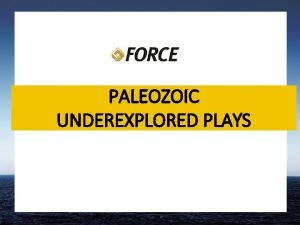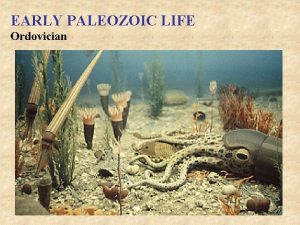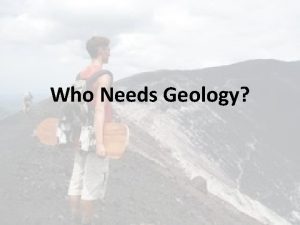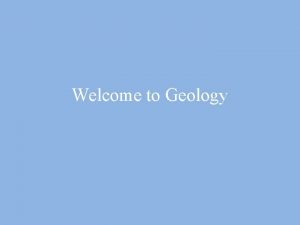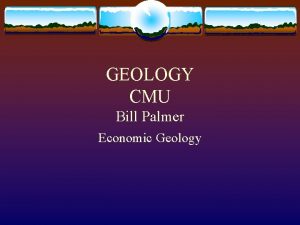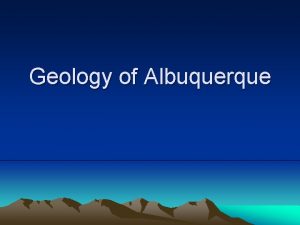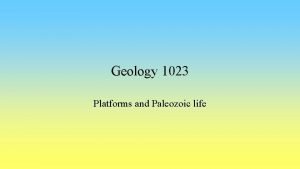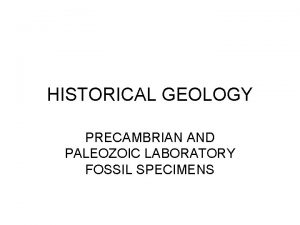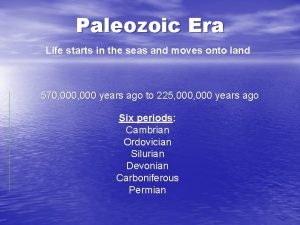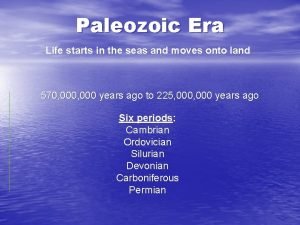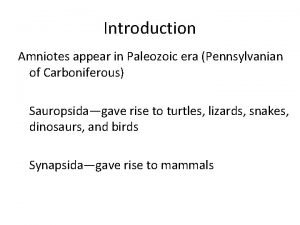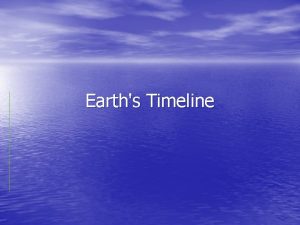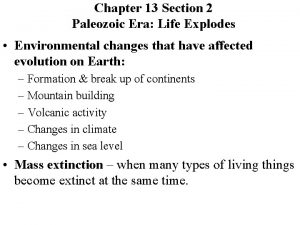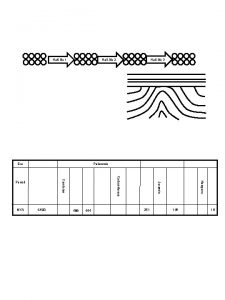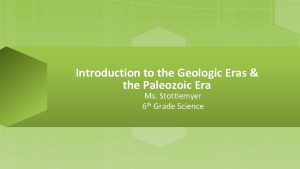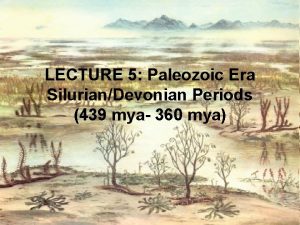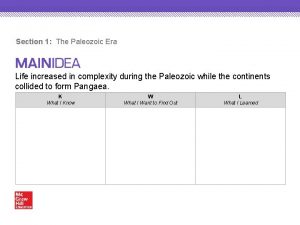The Geology of the Paleozoic Era The Paleozoic






























































- Slides: 62

The Geology of the Paleozoic Era

The Paleozoic Era. • Geologic periods in Paleozoic record 7% of Earth’s history • Cambrian, Ordovician, Silurian, Devonian Carboniferous (Miss. , Penn. ) Permian • Boundaries in the major divisions originally defined by changes in the fossil record • Start of the Paleozoic used to be defined by appearance of first easily visible fossils; later lowered to include small shelly fauna; then lowered further to first appearance of complex branching trace fossils.

Base of the Cambrian system Trace fossil Phycodes pedum New modes of locomotion

Welsh Lower Paleozoic Prof Adam Sedgwick (Cambridge) studied the Cambrian (including the Ordovician) based on superposition and structural geology. Roderick Murchison described and mapped the Silurian based on fossils. Together Sedgwick and Murchison defined the Devonian System in Devon and Cornwall. Murchison established the Permian in Russian. Charles Lapworth separated the Ordovician. Review: Origin of names

Paleozoic Overview • Global tectonic theme of the Paleozoic assembly of the supercontinent, Pangaea. • Deposition due to transgressions (and disconformities due regressions) of shallow continental (epeiric) seas. Interiors of continents were frequently flooded. • Formation of mountain belts at edges – Tectonic activities associated with the assembly of Pangaea.

Paleozoic Global Geology • Six major Paleozoic continents are recognized after Rodinia breakup • Gondwana - S. continents, India • Laurentia - North America, Greenland, part Gr. Britain • Baltica – Northern Europe • Siberia – Most of Northern Asia • Kazakhstania – part Central Asia • China - All of SE Asia and SE China

Transgression and Regressions Extinctions: Paleozoic Era key events http: //www. fmnh. helsinki. fi/users/haaramo/Meteor_Impacts/Middle_Paleozoic_impacts. htm Assembly of Pangea Gondwana/Laurasia Catskill Clastic Wedge Continues subd Iapetus South docks rest Avalonia Old Red SS Iapetus floor subducted Scotl Scan NE Can Lauentia and Baltica collide - Laurasia Avalonia collides with Laurentia

Paleogeographic Reconstructions and Maps • Geologists want to create maps of the Earth as it was in the past, • correctly position the continents for different time periods, and • reconstruct geography on the continents.

What data are used to do this as accurately as possible? • Paleomagnetism Latitude • Biogeography - Distribution of flora and fauna. • Climatology - Climate sensitive sediments Glacial drift, desert pavement, laterite soils, etc. • Tectonic Patterns – continuation of mountains • Can’t use Magnetic Stripes on ocean floor. Mesozoic and later

Global paleogeography for the Cambrian period All six continents occur at low paleolatitudes Ocean waters circulate freely/ poles appear ice-free Epeiric seas cover much of continents except Gondwana Highlands in N Gondwana, Eastern Siberia, Central Kazakhistan Six major Paleozoic continents are recognized after Rodinia breakup Laurentia - North America, Greenland, Scotland Rotated 90 o Baltica - Russia (W of Urals), Scandinavia Siberia - Russia (E of Urals), Part Asia Kazakhstania - Kazakhstan China - All of SE Asia and SE China Gondwana - S. continents, India

Ordovician - Silurian SILURIAN – Silurian collision of Baltica/Laurentia Caledonian Orogeny, suturing forms Laurasia -----------------ORDOVICIAN – Ordovician Gondwana moved 40 o S to a South Pole location (Glaciers formed, we find L. Ord. tillites) – Baltica moved S, then N – Avalonia collided with Laurentia (Taconic Orogeny)

How do we check our paleolatitude data? L. Ordovician biogeography of Carolinites genacinaca Confirms paleomagnetic latitudes From Mc. Cormick & Fortey 1999. J. Paleontol. 73(2): 202 -18. ) Trilobite Paleogeography

Global paleogeography Mid Ordovician to Silurian Siberia moved from equatorial to northern temperate latitudes Small piece of Avalonia hits in Ordovician Baltica moved S, then N and collided with Laurentia, rotated 30 o Gondwana moved South , land in south high latitudes(Late Ord. tillites)

http: //www. geodynamics. no/Platemotions/500 -400 M. Ordovician http: //www. gl. rhbnc. ac. uk/seasia/Bio eog_pdfs/Fortey_Cocks. pdf Saucrorthis Mostly distinct faunas Continents were not close

Paleogeography Early Devonian Continued collision of Baltica/Laurentia formed Laurasia. Caledonian Orogeny finishes in E. Dev Acadian Orogeny in the Appalachians folds older rocks M. Dev. Other orogenies: Antler (Cordillera) and Ellesmere Gondwana moves to higher southern latitudes. All other continents at low northern latitudes. (northwest margin of Laurentia)

How close were Laurasia = Euramerica and Gondwana in the Late Devonian? Euramerica is Laurentia plus Baltica Dalmanitidae Looks like Oklahoma was close to Morocco Late Devonian Faunal Similarities Reedops Dicranurus

Final Assembly of Pangea • Permian – Kazakhstania collided with Baltica, forming the Urals • Single continent surrounded by Panthalassa Ocean w Tethys Sea ____________________ • Pennsylvanian – Siberia collided with Kazakhstania, forming Altai Mts. • Laurasia collides with Gondwana to reform Appalachians and to form Hercynian Mts. in Late Paleozoic. Hercynian collision forms Europe

Gondwana – Laurasia collision Hercynian orogeny North and South Europe suture Hercynian Orogeny continuous w Allegheny Orogeny about 300 mya

Final Assembly of Pangaea • After the suturing of Gondwana and Laurasia (includes Hercynian and Allegheny Orogenies), • Then: • Siberia collided with Kazakhstania in the Pennsylvanian, forming the Altai Mountains. • Kazakhstania collided with Baltica in the Permian, forming the Ural Mountains.

Paleogeography Late Permian Allegheny Orogeny Hercynian N Eur-S Eur

Next let’s look closer at the Collisional Mountains Paleozoic Era key events Rifting raises water, moves plates, which later collide. Assembly of Pangea Gondwana/Laurasia Catskill Clastic Wedge Continues subd Iapetus South docks rest Avalonia Old Red SS Iapetus floor subducted Scotl Scan NE Can Lauentia and Baltica collide - Laurasia Avalonia collides with Laurentia

Tectonics Paleozoic North America • In the Cambrian, several small terranes lay to the south of Laurentia as it separated from Baltica. The shores were passive margins. • In the Ordovician, about 500 mya, the direction of plate motion reversed and Iapetus began to close.

Global paleogeography for the Cambrian period Avalonia Terranes

The Taconic orogeny Rodinia breaking up Avalonia Terrane E. Cambrian Plates reverse, in E. Ordovician Laurentia moves toward Avalonia Africa moves toward both

Taconic orogeny (cont) Mid – L. Ordovician, N. Avalonia and an island arc dock with Laurentia, beginning the Appalachians Rocks thrust up over margin of Laurentia

Cambrian paleogeography Submerged Pre –collisions Note equator Submerged

Interior of Laurentia, Ord. -Silurian • Inland, the Taconic collisions caused the crust to be warped down, forming the Appalachian FORELAND BASIN • Deep water sediments were deposited in the basin, until sediments eroded from the Taconic mountains filled the basin, and shallow water deposits prevailed. • The Queenston Clastic Wedge.

Paleogeography N. Am. M Ord-Sil. Post collisions Barrier Reefs Highstand Evaporites Lowstand Queenston Clastic Wedge

Queenston clastic wedge Hardyston Fm downfolded (Martinsburg Shale) (Allentown Dm. , Jacksonburg Ls. )

The Caledonian Orogeny • Baltica sutured onto Laurentia – Mountains - Nova Scotia to Scandinavia – Erosion resulted clastic wedge – Devonian Old Red Sandstone • Result called Euramerica or Laurasia

Late Silurian - Early Devonian Caledonian Orogeny-Laurasia forms Caledonian Orogeny To our North

The Acadian Orogeny • Continued subduction of Iapetus ocean floor in Devonian • Additional parts of Avalonia docked with Laurentia – Erosion resulted Catskill clastic wedge – Facies change in foreland basin – shallow marine to streams in Middle Devonian as basin fills – Field trip fossil collecting Marcellus to Mahantango Centerfield Reef

Early - Mid Devonian Acadian Orogeny-Laurasia forms Acadian Orogeny Southern Avalonia into Laurasia

Accreted terranes (Does this remind you of somewhere else? )

Late Devonian paleogeography of North America

Catskill Formation Clastic Wedge from Acadian collision w rest of Avalonia E-Mid Devonian docking By L. Dev. filled, mostly stream deposits, floodplains have fossils of land plants and amphibians Oxidation state of Iron depended on oxygen levels

Catskill clastic wedge thickness Coarse near source Wedge thins away

Carboniferous BIG Collision with Gondwana The Allegheny Orogeny • Initial contact Late Mississippian • Northwest Africa collided • Folding of Pennsylvanian rocks proves long duration • Deformation much more extensive than the Taconic or Acadian – New England to Alabama

Physiographic provinces Appalachians little deformation at collision suture, very metamorphosed and intruded Northwest thrust faults and northeast anticlines and synclines Grenvillian rocks thrust cratonward

Allegheny and Ouachita Orogenies Hercynian Allegheny Ouchita hit by South America Allegheny hit by Africa

Western: Antler Orogeny • • • In the Devonian, a westward dipping subduction zone formed off Western Laurasia. An Island Arc formed, the Klamath Arc The ocean floor between subducted as the arc approached and collided with the continent Late Devonian to Early Mississippian Called the Antler Orogeny, basin thrust East Klamath Mts. and North Sierra Nevada Antler Mts. are folded basin sediments Beginning of Cordillera Construction, Devonian to Mississippian

Late Devonian paleogeography of North America Here it is

Paleozoic structure of the West • Devonian – Ouachita Orogeny creates compressional stress Exposed granite eroded as arkoses (feldspar-rich sandstones) • Pennsylvanian – blocks push up along high angle faults, relieving the stress. Pre. Cambrian basement exposed. • Resulted in Front Range Uplift CO & WY • Uncompahgre Uplift CO & NM

Pennsylvanian arkose, CO Fountain Arkose, CO, deposited northeast of Front Range Uplift

Next: Cratonic Sequences • Laurence Sloss: Major transgressive-regressive cycles • 4 in Paleozoic • Allow long range correlation “Sequence Stratigraphy” • Transgression: nearshore sand covered by muds and/or carbonates “fining upward” • Regression: – Nearshore: erosion and disconformity – Far offshore: sediments “coarsening upward”

Transgression and Regressions Paleozoic Era key events Assembly of Pangea Low High ABS: Sea level rise (cyclic) due Gondwana glaciation Penn-Pm regression due slowdown spreading, assembly of Pangaea, drained continent L Pm KS: filling in of the Appalachian foreland basin by Late Devonian time TC: glacial melting and accelerated sea-floor spreading Sauk: High rates of sea-floor spreading

Cambrian – E Ord Sauk Sequence Pre-collision, dramatic transgression due active MORs Note extensive shallow carbonates and equator

Time-transgressive Cambrian rocks Grand Canyon Sauk Sequence WEST Transgression Middle Cambrian http: //www. geo-tools. com/trilobites. htm Lower Cambrian http: //www. wmrs. edu/projects/trilobites/images/trilo 7 -2. jpg Note how western BAS is older than eastern BAS EAST

Tippecanoe Transgression M Ord-Sil. Reworking of Sauk sands gives pure sands useful in glass manufacture. Sands covered by carbonates as transgression advances Michigan Basin surrounded by reefs Restricted circulation caused evaporite precipitation Source of Rock Salt About 5 smaller T-R Pulses

Late Devonian Kaskasia Transgression Carbonates over pure sands Williston Basin surrounded by reefs Restricted circulation caused evaporite precipitation

Absoroka Sequence • Transgression starts M Pennsylvanian • Regression starts L Pennsylvanian • Cyclothems (pulses) reflect Glacial sealevel var. PERMIAN dry interior • Inland sea limited to w Texas & s NM • Extensive evaporite deposits KS – OK • Redbeds over interior

Climate/Sedimentation Paleozoic Era key events Rifting raises water, moves plates, which later collide and fold. Folding makes deep basin. If fold basin sediments, uplift. Assembly of Pangea

Next: Paleozoic Climates • Paleozoic mostly warm, but two glacial times, Ordovician and Pennsylvanian to Late Permian. • Cool Middle Ordovician – CO 2 tied up in carbonates – no greenhouse – Extensive Gondwana tillites and striations – Sea level retreats as glacier holds water

Late Paleozoic Climates (1) Cool Pennsylvanian – M Permian – CO 2 tied up in carbonates – Extensive Gondwana tillites and striations – sea-level fluctuations due glacial (slow regression) and interglacial (fast melt) “cyclothems” – Generated Coal deposits, carbon reservoirs, low CO 2

Pennsylvanian Glacier -Gondwana Sea-level falls as glaciers grow, inland seas retreat

Pennsylvanian Cyclothems Rapid transgressions cover swamp as ice melts Coal Swamp swamp estuary Slow regression as ice sheet grows

Coal formation Pennsylvania cyclothems Melting glacier Highland source to east

Pennsylvanian-age coal deposits

Late Paleozoic Climates - 2 (2) The Late Permian WARM • Pangaea was ice-free • Warm equatorial waters from the Panthalassa Ocean reached both poles. • No glaciers = no coal (need rapid transgression) • The Gondwana landmass had drifted north into warmer climates. • reduced coal formation caused carbon dioxide levels to rise • Greenhouse effect

L. Permian Pangaea Ice-free, dry interiors, no coal Much of land +/- 30 degrees Pangaea is assembled, sea-level low Hot, dry climate Note evaporites

PERMIAN N. America • Inland sea limited to w Texas & s NM • Extensive evaporite deposits KS – OK • Redbeds over interior – strong seasons

Next Time • A survey of Paleozoic Life, and • Latest Permian Mass Extinction – Most profound in history of life.
 Cenozoic mesozoic paleozoic
Cenozoic mesozoic paleozoic Pangea paleozoic era
Pangea paleozoic era Elizabethan era vs victorian era
Elizabethan era vs victorian era Creí que era una aventura y en realidad era la vida
Creí que era una aventura y en realidad era la vida Vi uma estrela tão alta
Vi uma estrela tão alta Baroque music quiz
Baroque music quiz What was the late paleozoic
What was the late paleozoic Crucible
Crucible Paleozoic supercontinent
Paleozoic supercontinent Cenozoic mesozoic paleozoic
Cenozoic mesozoic paleozoic Oblique fault
Oblique fault Prem geology
Prem geology Geology
Geology Thrust fault
Thrust fault Geology
Geology Geology
Geology Iowa state geology
Iowa state geology Kink method structural geology
Kink method structural geology Focal point engineering
Focal point engineering What is geology
What is geology Principle of lateral continuity geology
Principle of lateral continuity geology Mohr's circle
Mohr's circle Weathering video
Weathering video Suez canal geology
Suez canal geology Geology of cuba:
Geology of cuba: Geospere
Geospere Geology lecture series
Geology lecture series Inorganic definition geology
Inorganic definition geology Jens hilke
Jens hilke Www.geology.sk
Www.geology.sk Wjec a level geology
Wjec a level geology Geology vocabulary
Geology vocabulary What type of rock
What type of rock Steno's laws of stratigraphy
Steno's laws of stratigraphy Rock matter
Rock matter Earth science vs geology
Earth science vs geology Graded bedding
Graded bedding Geological structures
Geological structures Https://geology.com/rocks/
Https://geology.com/rocks/ Polytypism geology
Polytypism geology Solid geology
Solid geology Mineral council australia
Mineral council australia Rule of v's geology
Rule of v's geology Joints geology
Joints geology Geology
Geology Latvian environment geology and meteorology centre
Latvian environment geology and meteorology centre Geology
Geology Geol 351
Geol 351 Accretion geology
Accretion geology What is geochemistry in geology
What is geochemistry in geology Dharma wijewickreme
Dharma wijewickreme Grade 2 science worksheets
Grade 2 science worksheets Geology earth science definition
Geology earth science definition Basin and range geology
Basin and range geology Uw
Uw Fault geology
Fault geology Geology
Geology Clay basin storage
Clay basin storage Confined and unconfined aquifer
Confined and unconfined aquifer Lithification definition geology
Lithification definition geology Geology grain size card
Geology grain size card Disconformity definition geology
Disconformity definition geology Grenville province geology
Grenville province geology

